Spices, especially the likes of the turmeric spice, infuse life into numerous dishes across Asian countries and beyond. Boasting a bright yellow color, turmeric offers a unique flavor and brings a wealth of health benefits, including its potent anti-inflammatory properties. But what if this popular spice is unavailable in grocery stores, or you’re seeking a slightly different taste or color for a dish? Here’s a guide to the 21 best substitutes for turmeric to rescue your culinary endeavors.
This post contains affiliate links.
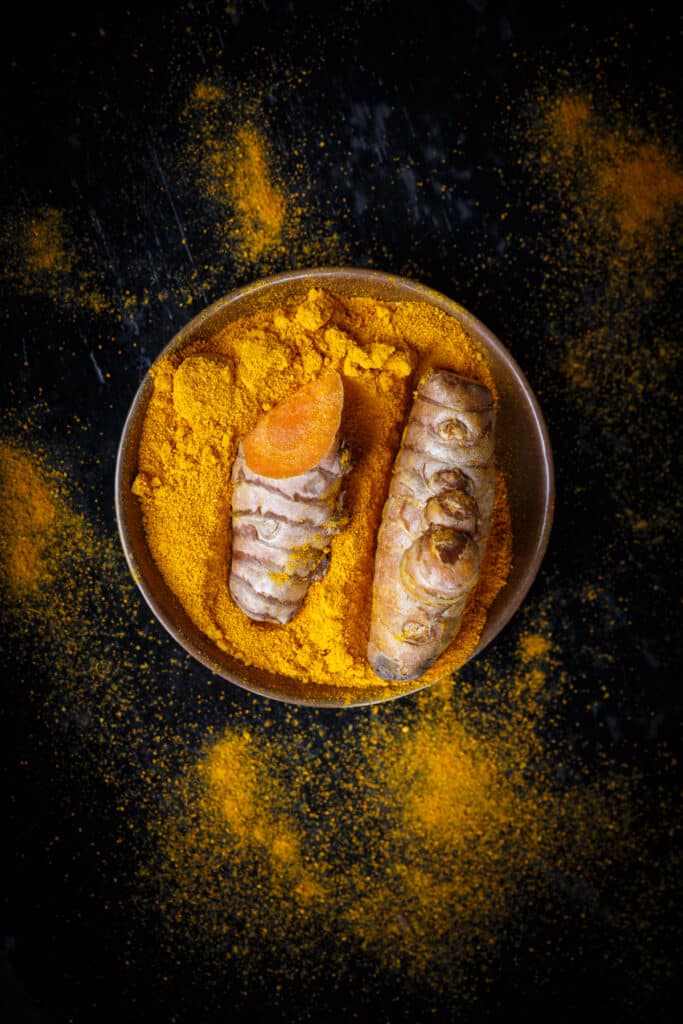
What is turmeric?
Turmeric, known as the golden culinary spice (golden-yellow in color with a tinge of orange), is derived from the turmeric root of the Curcuma longa plant, a member of the ginger family. Originally from Southeast Asia, it’s become an integral part of many Asian cuisines. Its active ingredients, most notably curcumin, have earned it admiration not just for its unique flavor but also for its health benefits.
What Foods is Turmeric Traditionally Used in?
Turmeric is a staple in many savory dishes:
- Traditional Indian curries and lentil soups benefit from its earthy taste.
- Turmeric root also graces Southeast Asian recipes, like Indonesian yellow rice.
- Drinks such as the comforting Indian “golden milk” and trendy Western turmeric lattes.
- Modern concoctions like turmeric smoothies and baked goods showcase its versatility.
What are the health benefits of turmeric?
Turmeric has been shown to have many health benefits. It has been shown to improve not only your physical health but also your psychological well-being.
How Turmeric Can Benefit Your Physical Health
Turmeric, often referred to as the “golden spice,” has been used for centuries as a culinary ingredient and a medicinal herb in traditional practices like Ayurveda. The most potent component of turmeric is curcumin, which is responsible for most of the spice’s health benefits.
Curcumin is a powerful anti-inflammatory agent. Inflammation, in controlled amounts, is beneficial as it helps the body fight foreign invaders. However, chronic, low-level inflammation can majorly affect many chronic Western diseases, including heart disease, cancer, Alzheimer’s, and metabolic syndrome. Curcumin’s ability to target multiple steps in the inflammatory pathway at the molecular level makes it a potent natural anti-inflammatory compound.
It’s important to note that curcumin is not easily absorbed into the bloodstream. Consuming it with black pepper, which contains piperine, can enhance its absorption. This is why you’ll often see curcumin supplements recommended to be taken with piperine or black pepper.
How Turmeric Can Benefit Your Mental Health
Curcumin has shown potential in treating depression. In a study, 60 individuals with depression were divided into three groups: one took Prozac, the second took 1 gram of curcumin, and the third took both.
After 6 weeks, curcumin’s effects were found to be comparable to Prozac, with the combination of both showing the best results. The research suggests curcumin might be as effective as an antidepressant.
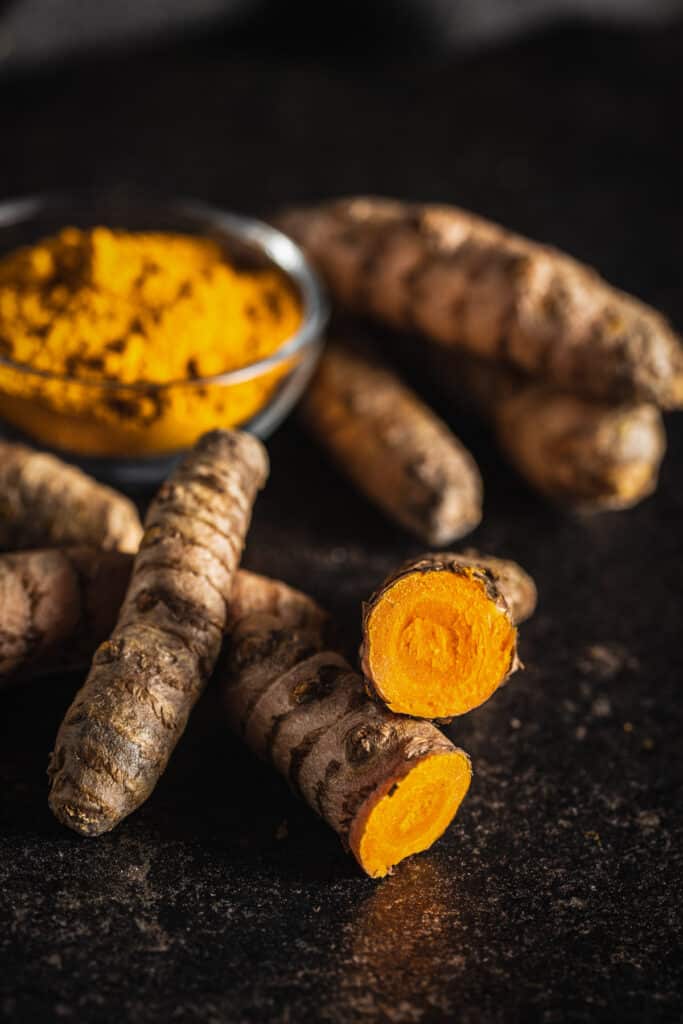
Dried Vs. Fresh Turmeric
While dried turmeric is ground into a fine powder, fresh turmeric resembles ginger—a knobby root. The dried form is more concentrated, so you’ll need less of it compared to fresh turmeric. Fresh turmeric has a slightly zestier taste, and its shelf life is shorter. It’s recommended to use them interchangeably based on availability and the specific dish.
Looking for a tasty recipe that includes turmeric? Try this incredible Coconut Noodle Soup!
21 Best Turmeric Substitutes
As versatile as turmeric is in the culinary world, there are times we need an alternative, either for flavor, health reasons, or mere availability. Here are the 21 best substitutes that can come to your rescue.
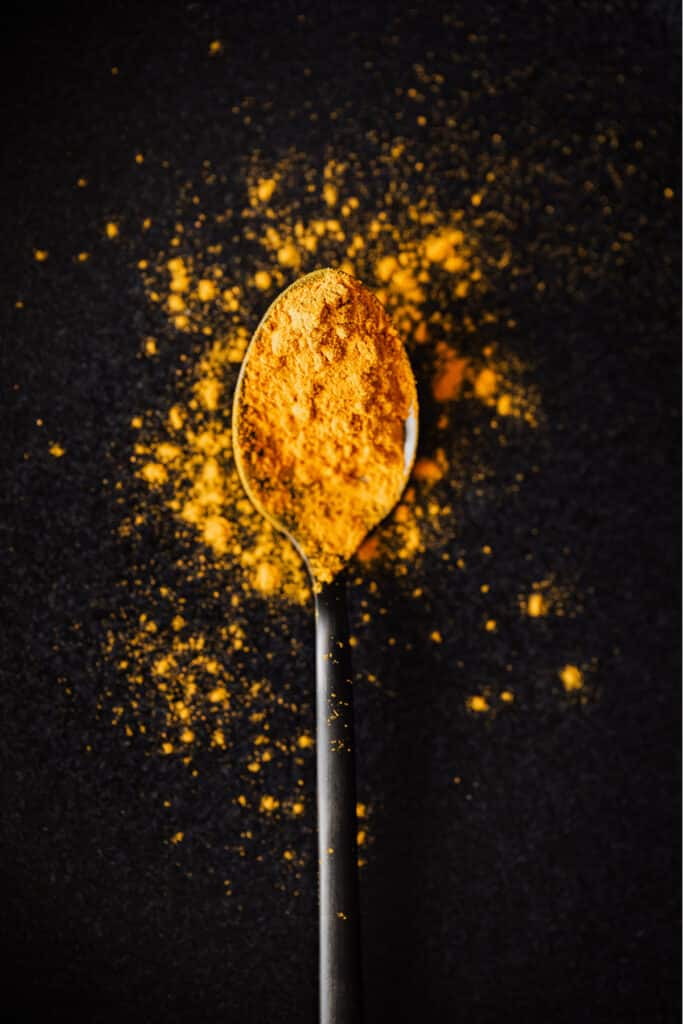
- Fresh Turmeric
While it’s the very thing you might be substituting, it’s worth noting that using it in its fresh form can offer a milder flavor than its powdered counterpart. It’s perfect for grating into curries, smoothies, or even teas. If you are looking for a substitute for ground turmeric, using fresh instead is a great option.
Recommended ratio: For a recipe that calls for one teaspoon of turmeric powder, substitute 1-inch fresh turmeric. - Turmeric Paste
Typically made from freshly ground turmeric, water, and sometimes black pepper for enhanced absorption. This is a versatile and concentrated way to incorporate turmeric. Turmeric paste is a great alternative to both fresh and ground turmeric.
Recommended ratio: For a recipe that calls for one teaspoon of turmeric powder, substitute one teaspoon of turmeric paste. - Turmeric Powder
The most commonly used form of turmeric is dried and ground turmeric. It’s the perfect substitute for recipes that call for fresh turmeric or turmeric paste.
Recommended ratio: For 1-inch fresh turmeric, substitute a teaspoon of turmeric powder. - Fresh Ginger
Zesty with a warm, woody aroma, fresh ginger is versatile. It’s used in everything from stir-fries and curries to desserts and teas.
Recommended ratio: For a recipe that calls for 1-inch fresh turmeric (or one teaspoon of turmeric powder), substitute half to one-inch fresh ginger root. - Ginger Paste
Packed with the same zesty punch as fresh ginger. This paste is a convenient ingredient for Asian curries, marinades, and some baked goods.
Recommended ratio: For a recipe that calls for one teaspoon of turmeric powder, substitute half to one teaspoon of ginger paste. - Ginger Powder
More subdued than its fresh counterpart. Ginger powder is a go-to for baking, spice blends, and dry rubs, offering a sweet yet spicy undertone.
Recommended ratio: For a recipe that calls for 1-inch fresh turmeric (or one teaspoon of turmeric powder), substitute a half teaspoon of ginger powder. - Fresh Galangal
Citrusy and sharp flavor. Galangal is a must in Thai and Indonesian dishes like Tom Kha Gai soup and rendang.
Recommended ratio: For a recipe that calls for 1-inch fresh turmeric, substitute a half teaspoon of galangal powder. - Galangal Paste
With its concentrated form, this paste is perfect for Southeast Asian curries and gravies that require an aromatic, sharp kick.
Recommended ratio: For one teaspoon of turmeric paste, substitute one teaspoon of galangal paste. - Galangal Powder
A muted version of the fresh root, it’s used in spice blends or dry mixes where a hint of galangal’s signature zest is desired.
Recommended ratio: For 1-inch fresh turmeric (or one teaspoon of turmeric powder), substitute a half teaspoon of galangal powder. - Saffron
Distinctly floral with a honeyed hint, saffron is a luxury ingredient cherished in paellas, risottos, and Middle Eastern desserts.
Recommended ratio: For 1-inch fresh turmeric (or one teaspoon of turmeric powder), substitute a quarter teaspoon of saffron.
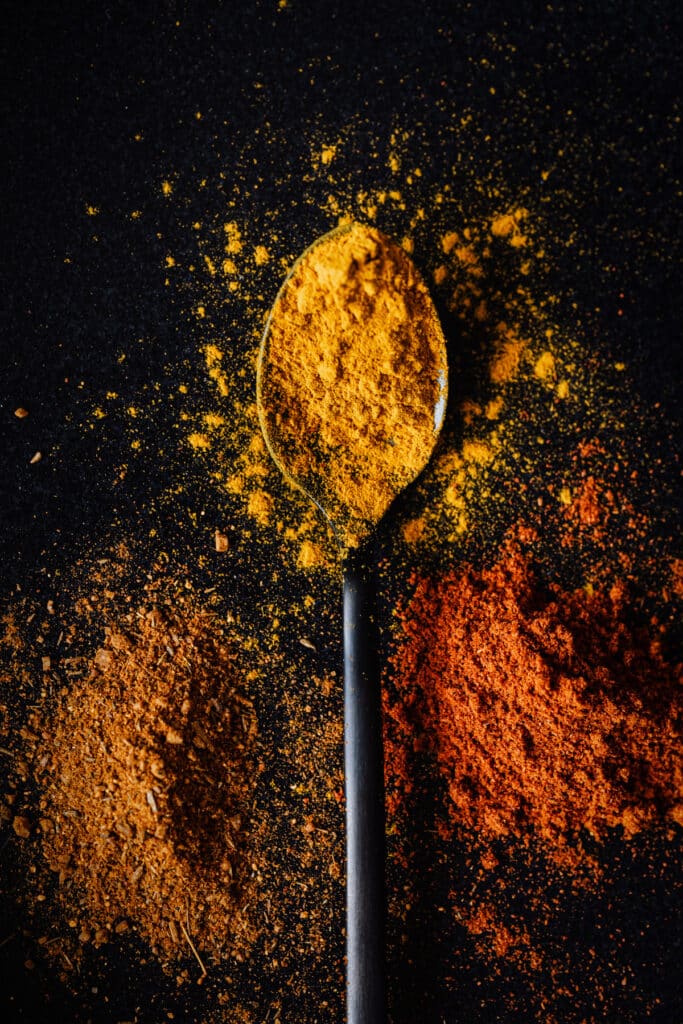
- Safflower
Milder than saffron, it primarily imparts color and is often used in cooking oils or as a more affordable alternative to saffron in dishes.
Recommended ratio: For 1-inch fresh turmeric (or one teaspoon of turmeric powder), substitute a one-and-a-half teaspoon of safflower. - Curry Powder
Aromatic and diverse in flavor—thanks to its blend of spices—curry powder is a base for many Indian and Caribbean dishes, providing warmth and depth.
Recommended ratio: For 1-inch fresh turmeric (or one teaspoon of turmeric powder), substitute a teaspoon of curry powder. - Paprika
Sweet and slightly fruity, paprika is a staple in Hungarian and Spanish cuisines, gracing dishes like goulash and chorizo.
Recommended ratio: For 1-inch fresh turmeric (or one teaspoon of turmeric powder), substitute one teaspoon of paprika. - Smoked Paprika
Infused with a smoky flavor, it’s a favorite in Spanish dishes, BBQ rubs, and anywhere a touch of smoke is desired.
Recommended ratio: For 1-inch fresh turmeric (or one teaspoon of turmeric powder), substitute one teaspoon of smoked paprika. - Yellow Mustard Seeds
Pungent and slightly spicy, they’re essential for pickling and are often popped in hot oil to start many Indian dishes.
Recommended ratio: For 1-inch fresh turmeric (or one teaspoon of turmeric powder), substitute half to one teaspoon of yellow mustard seeds. - Mustard Powder
Sharp and tangy, this powder is a key ingredient in mustard sauces, dressings, and certain marinades.
Recommended ratio: For 1-inch fresh turmeric (or one teaspoon of turmeric powder), substitute half to one teaspoon of mustard powder. - Cumin Seeds
Warm and earthy with a citrus undertone, cumin seeds are prevalent in Middle Eastern, Latin American, and Indian cuisines.
Recommended ratio: For 1-inch fresh turmeric (or one teaspoon of turmeric powder), substitute half to one teaspoon of cumin seeds. - Cumin Powder
Offering the same flavor profile but in a concentrated form, it’s used widely in taco seasonings, chili powders, and Indian masalas.
Recommended ratio: For 1-inch fresh turmeric (or one teaspoon of turmeric powder), substitute half to one teaspoon of cumin powder. - Garam Masala
Warm and sweet due to its blend of spices like cinnamon, mace, and cardamom, it’s a finishing touch in many North Indian dishes.
Recommended ratio: For 1-inch fresh turmeric (or one teaspoon of turmeric powder), substitute half to one teaspoon of garam masala. - Annatto Seeds
Mildly peppery with a hint of nuttiness, these seeds are predominantly used in Latin American and Filipino cuisines for both flavor and color.
Recommended ratio: For 1-inch fresh turmeric (or one teaspoon of turmeric powder), substitute half to one teaspoon of annatto seeds. - Ground Annatto
Offering the same nutty, peppery profile in an easy-to-use form, it’s common in spice blends and traditional dishes like achiote chicken.
Recommended ratio: For 1-inch fresh turmeric (or one teaspoon of turmeric powder), substitute half to one teaspoon of ground annatto.
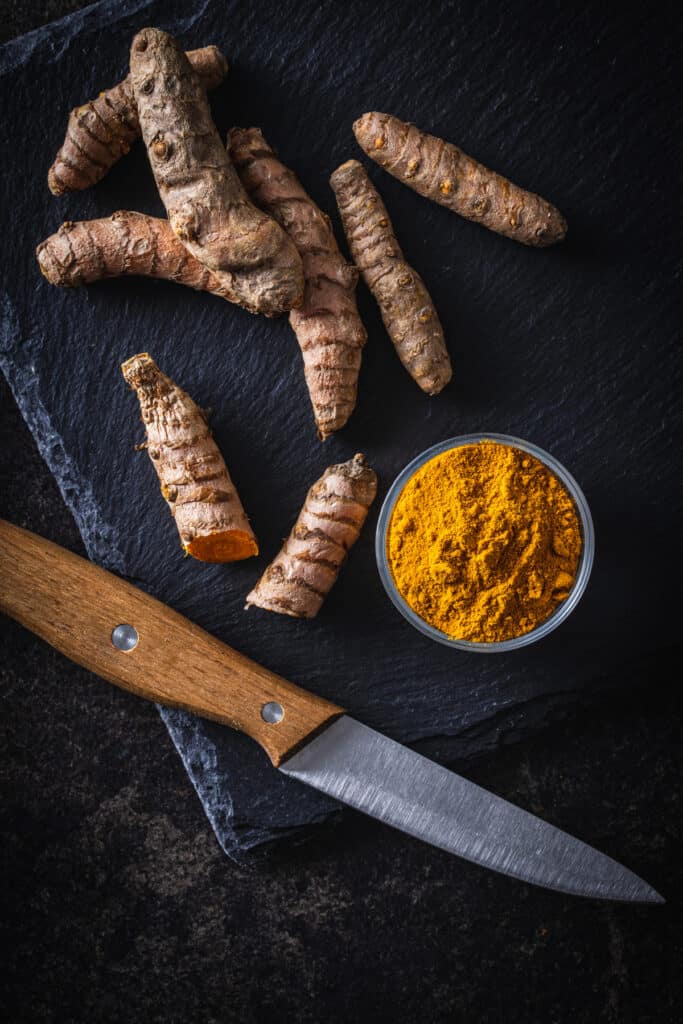
FAQ
Ginger, a part of the Zingiberaceae family, comes closest in terms of taste. Both come from the same plant family and share a similar earthy, mildly spicy profile.
However, ginger is zestier and sharper. When substituting, it’s essential to adjust quantities and be prepared for a slight variation in the dish’s final taste.
Reasons range from allergies to simple unavailability. Also, some might prefer a different flavor profile.
In most recipes, 1 inch of fresh turmeric can be swapped for one teaspoon of dried, but expect a slight shift in flavor.
Yes, you can omit turmeric from a recipe, especially if it’s used in small quantities primarily for color. However, leaving it out may alter the dish’s depth of flavor and color.
If turmeric’s primary role in the recipe is for its health benefits or distinct taste, you might notice its absence more. In many cases, the dish will still be delicious without it, just slightly different.
Turmeric imparts a warm, earthy, and slightly bitter flavor to dishes. It has a mustardy aroma and can add a gentle spiciness without being overly hot.
The unique taste profile of turmeric is subtle yet can provide depth to various dishes, enhancing other flavors without overpowering them. Additionally, turmeric is often valued for the rich, golden-yellow hue it lends to recipes.
Some do, like saffron and annatto, but others, like ginger or cumin, won’t.
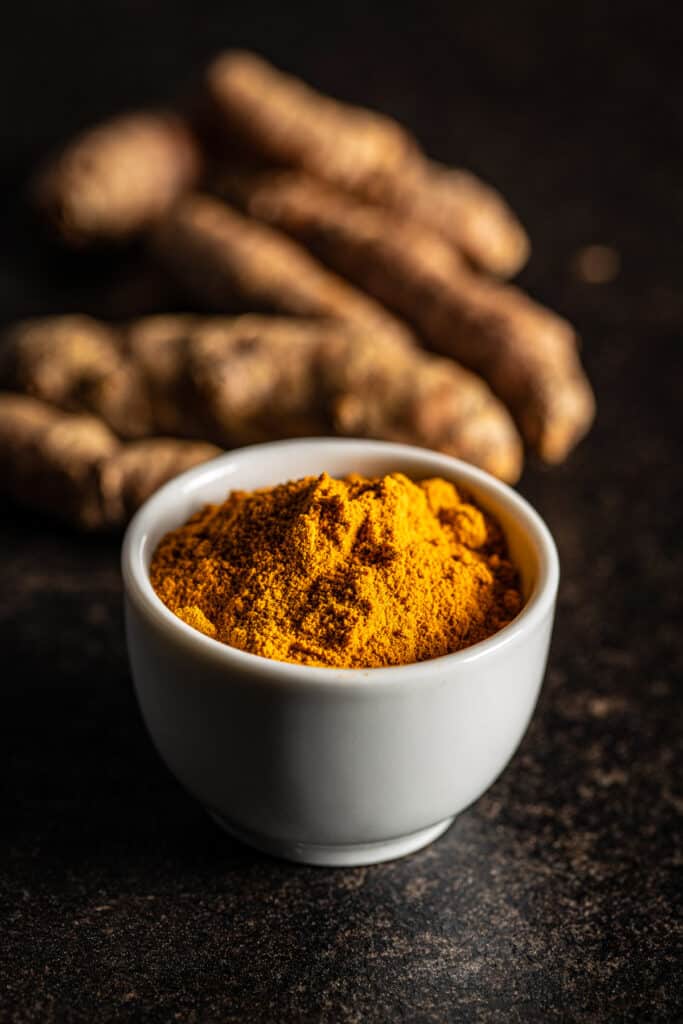
Final Words: What are the Best Turmeric Substitutes?
Experimentation in the culinary world is both fun and often necessary. While turmeric holds a special spot, sometimes a change in terms of color or a slightly different taste can elevate a dish.
Whether it’s for health reasons, availability, or just a change in the usual routine, these turmeric alternatives can offer something special to your plate. Dive in, and let the spices guide your culinary journey.
This post may contain affiliate links, meaning I’ll receive a commission if you purchase through those links at no extra cost to you. Please read our full disclosure for more information. Thank you for supporting Raepublic.
